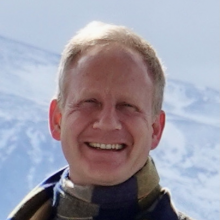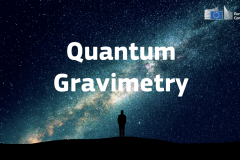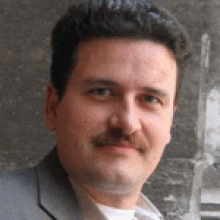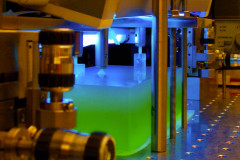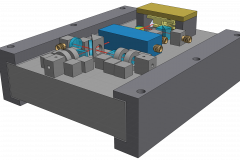To: 21/05/2025 14:00
The Nonlinear Bio-Imaging Lab, in collaboration with the FAIR CHARM consortium, is developing new nonlinear imaging platforms to meet diverse biological challenges. In this talk, I will present recent results from two complementary systems: the SWIM microscope, designed for deep, label-free imaging, and SLIDE, designed for ultrafast volumetric acquisition.
Using SWIM, we are developing AI-assisted cell detection from THG images of stained histological samples of human skin, and are now extending this approach to unstained ex vivo biopsies as a step toward in vivo 3D skin microscopy. We also apply SWIM to label-free imaging of mucus in lung models, where we visualize mucus volume, structure, and flow behavior without the need for fluorescent tracers.
With SLIDE, we demonstrate detection of stem cells in whole, unfiltered blood. Harmonic nanoparticle-labeled cells are imaged in flow using a diffractive scanning geometry driven by a wavelength-swept FDML laser. AI segmentation and downstream analysis distinguish isolated cells from aggregates, supporting future applications for in vivo tracking of rare cells circulating in the bloodstream.
Both systems are based on parametric excitation of harmonic signals, but differ in optical design and laser source. SWIM uses a tunable femtosecond OPA source (1250–1800 nm) for deep tissue imaging via 3P and THG processes, while SLIDE uses narrowband pulses and diffractive scanning to achieve 40 Hz 3D imaging at subcellular resolution. Together, these platforms broaden the reach of multiphoton microscopy in both depth and speed, from static 3D tissue structure to dynamic processes.
Funding

For RamanBC, we are developing an optical bread board which combines the light from two optical fiber via an acousto-optic modulator into a third fiber. The acousto-optic modulator allow us to shift the frequency of the light and create extremely well controlled pulses. We aim at frequency control in the Hertz region and amplitude control exceeding 100dB. This project will be carried out in collaboration with excel, which is Europe's leading company for navigation sensors and producer of a Quantum gravity sensor based on atom interferometry. The technology that we are creating for RamanBC is aimed at the first space mission, including a quantum gravity sensor (CARIOQA).

Funding

Abstract
Patent search analysis and consultancy services requested for the preparation of research projects on bioinspired printable biomaterials and hybrid addditive-subtractive manufacturing processes.
Technical Characteristics
- Strategic Project Scoping – Define research objectives, innovation potential, and alignment with EU/national priorities.
- Funding Opportunity Mapping – Identify suitable calls (e.g., Horizon Europe, national programs) and align project concepts accordingly.
- Consortium Building Support – Identify and engage academic, industrial, and public-sector partners; assist with agreements and commitments.
- Proposal Writing and Review – Draft or review technical, impact, and implementation sections; ensure clarity, coherence, and competitiveness.
- Technical Input on Research Design – Advise on bioinspired printable biomaterial development, hybrid processing workflows, and integration strategies.
- Regulatory and Standards Compliance – Advise on relevant legislation (e.g., REACH, biodegradability), certifications, and ethical issues.
- Intellectual Property Strategy – Support IP landscaping, protection plans, and exploitation pathways.
- Risk Analysis and Management Planning – Identify risks and propose mitigation measures in technical, legal, or financial areas.
- Project Budgeting and Work Plan Structuring – Assist with budgeting, defining work packages, deliverables, milestones, and KPIs.
Procedure
Contact Persons
Position Description
Synthesis of graphene-based conductive organic nanocomposites.
For the full announcement, follow the link "Related Documents"
Required Qualifications
- BSc degree in Chemistry or Materials Science
- Msc degree in Chemistry or Materials Science
- Experience in the position topic
Application Procedure
Interested candidates who meet the aforementioned requirements are kindly asked to submit their applications, no later than May 18, 2025, 23:59 local Greece time to the address (hr@iesl.forth.gr), with cc to the Scientific Responsible Dr Emmanuel Stratakis (stratak@iesl.forth.gr).
In order to be considered, the application must include:
- Application Form (please download file from the job announcement webpage (https://www.iesl.forth.gr/en/jobs-bids/jobs/job-positions)
- Brief CV
- Scanned copies of academic titles
- Certificate of enrollment in a PhD program
Appointment Duration
12Position Description
The Institute of Electronic Structure and Laser of the Foundation for research and Technology
Hellas (IESL -FORTH), in the framework of the project MULTICOOL(Hybrid, multifunctional cooling metamaterials for next-generation high-efficiency solar cells) is seeking to recruit three (3) post-doc positions.
Required Qualifications
- Bachelor in Physics
- Master in Physics
- PhD in Physics
- Good knowledge of English
- Experience in the theoretical and numerical study of electromagnetic wave propagation in complex systems
Desirable Qualifications
Position 1: Metasurface designing for solar cell radiative cooling
Position 2: Metasurface designing for asymmetric absorption of IR radiation
Position 3: Metasurface designing for direcional thermal radiation emission
Application Procedure
Interested candidates who meet the aforementioned requirements are kindly asked to submit their applications to the address (hr@iesl.forth.gr), with cc to the Scientific Responsible, Prof. Kafesaki Maria ( kafesaki@iesl.forth.gr ).
In order to be considered, the application must include:
- Application Form (Form Greek or Form English to the left)
- Detailed curriculum vitae (CV) of the candidate
- Scanned Copies of academic titles
Appointment Duration
7Position Description
Ο/Η υποψήφιος/α αναμένεται να εφαρμόσει προηγμένες τεχνικές φασματοσκοπίας λέιζερ με στόχο την ανάπτυξη καινοτόμων μεθόδων για την ανάλυση και τον χαρακτηρισμό υλικών και την διάγνωση προβλημάτων σε βιοϋλικά. Επίσης ο/η υποψήφιος/α αναμένεται να συμβάλει στην ανάπτυξη και εξέλιξη φασματοσκοπικών μεθόδων λέιζερ με σκοπό το χαρακτηρισμό βιοϋλικών.
Για το πλήρες κείμενο της πρόσκλησης ακολουθήστε τον σύνδεσμο 'Related Documents'
Required Qualifications
- Διδακτορικό στις φυσικές επιστήμες (Φυσική, Χημεία, Επιστήμη Υλικών ή συναφή πεδία) (30%)
- Υψηλού επιπέδου γνώση και εμπειρία στην εφαρμογή πειραματικών μεθόδων μελέτης και ανάλυσης υλικών (20%)
- Αποδεδειγμένη εμπειρία στη χρήση φασματοσκοπικών τεχνικών ανάλυσης υλικών (π.χ. Raman, FT-IR, Απορρόφηση, Φθορισμός, LIBS, SEM-EDS, XRF, απεικονιστικές τεχνικές κ.α.) (20%)
Desirable Qualifications
- Ερευνητικό / επιστημονικό έργο μετά την απόκτηση του διδακτορικού (επιστημονικές δημοσιεύσεις και παρουσιάσεις σε συνέδρια με αντικείμενο σχετικό με το έργο) (10%)
- Εμπειρία στην ανάπτυξη εργαστηριακών πειραματικών διατάξεων και οργανολογίας (10%)
- Εμπειρία στη χρήση χημειομετρικών/στατιστικών μεθόδων και εργαλείων επεξεργασίας αναλυτικών/φασματοσκοπικών δεδομένων (10%)
Application Procedure
Interested candidates who meet the aforementioned requirements are kindly asked to submit their applications to the address (hr@iesl.forth.gr), with cc to the Scientific Responsible, Dr P. Loukakos (loukakos@iesl.forth.gr).
In order to be considered, the application must include:
- Application Form (Form Greek or Form English to the left)
- Detailed curriculum vitae (CV) of the candidate
- Scanned Copies of academic titles
Appointment Duration
6Abstract
Consultancy services requested for the preparation of research projects on bio-based materials and hybrid manufacturing processes.
In particular:
- Strategic Project Scoping – Define research objectives, innovation potential, and alignment with EU/national priorities.
- Funding Opportunity Mapping – Identify suitable calls (e.g., Horizon Europe, national programs) and align project concepts accordingly.
- Consortium Building Support – Identify and engage academic, industrial, and public-sector partners; assist with agreements and commitments.
- Proposal Writing and Review – Draft or review technical, impact, and implementation sections; ensure clarity, coherence, and competitiveness.
- Technical Input on Research Design – Advise on bio-based material development, hybrid processing workflows, and integration strategies.
- Regulatory and Standards Compliance – Advise on relevant legislation (e.g., REACH, biodegradability), certifications, and ethical issues.
- Intellectual Property Strategy – Support IP landscaping, protection plans, and exploitation pathways.
- Risk Analysis and Management Planning – Identify risks and propose mitigation measures in technical, legal, or financial areas.
- Project Budgeting and Work Plan Structuring – Assist with budgeting, defining work packages, deliverables, milestones, and KPIs.
Technical Characteristics
Procedure
Contact Persons
Abstract
Consultancy services requested for the preparation of research projects on bio-based materials and hybrid manufacturing processes.
In particular:
- Strategic Project Scoping – Define research objectives, innovation potential, and alignment with EU/national priorities.
- Funding Opportunity Mapping – Identify suitable calls (e.g., Horizon Europe, national programs) and align project concepts accordingly.
- Consortium Building Support – Identify and engage academic, industrial, and public-sector partners; assist with agreements and commitments.
- Proposal Writing and Review – Draft or review technical, impact, and implementation sections; ensure clarity, coherence, and competitiveness.
- Technical Input on Research Design – Advise on bio-based material development, hybrid processing workflows, and integration strategies.
- Regulatory and Standards Compliance – Advise on relevant legislation (e.g., REACH, biodegradability), certifications, and ethical issues.
- Intellectual Property Strategy – Support IP landscaping, protection plans, and exploitation pathways.
- Risk Analysis and Management Planning – Identify risks and propose mitigation measures in technical, legal, or financial areas.
- Project Budgeting and Work Plan Structuring – Assist with budgeting, defining work packages, deliverables, milestones, and KPIs.


